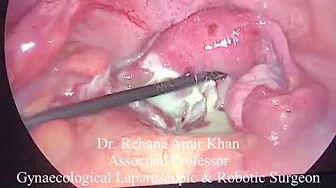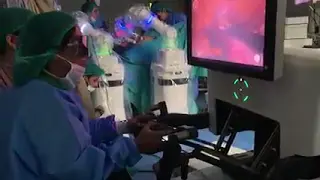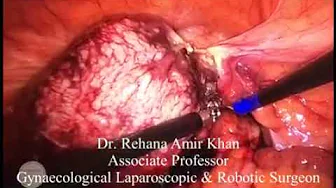Diagnostic Laparoscopy
DIAGNOSTIC LAPAROSCOPY
What do you need to Know about Diagnostic Laparoscopy?

During a diagnostic laparoscopy, we will fill your abdomen (belly) with gas and use a laparoscope (a long, thin camera) and surgical instruments to examine organs in your abdomen or pelvis.
Diagnostic laparoscopy is a minimally invasive procedure.
Diagnostic laparoscopy allows us to:
Having a laparoscopy instead of traditional (open) surgery means you may experience less pain and bleeding after surgery. People who undergo laparoscopy are often able to go home and return to normal activities sooner than those who undergo open surgery. Most women who undergo laparoscopy start walking, eating, and drinking within 24 hours of surgery.
Laparoscopy can be done during your hospital stay (inpatient) or as an outpatient procedure. If it's done on an outpatient basis, you may be able to go home the same day.
Before Laparoscopy
Your nurse will give you a resource on preparing for your procedure. Your nurses and doctors will also give you more information about your procedure.
If you go home on the day of surgery, you will need to arrange for someone to take you home. For a few hours after surgery, you will feel sleepy from the anesthesia (a drug that puts you to sleep during the procedure). Tell your nurse if no one takes you home.
Wear or carry loose, comfortable clothing around the house. Your abdomen may be swollen or slightly painful after surgery.
During Laparoscopy
You will be taken to the operating room and assisted on the operating table. An anesthesiologist (a specialist or nurse who will give you anesthesia) will insert an intravenous (IV) line into a vein, usually in your arm or hand. You will be given fluids and anesthesia using an IV line during the procedure. The anesthesiologist will also monitor your heart rate and breathing throughout the procedure.
After you fall asleep, a catheter (a thin, flexible tube) will be placed in your bladder to drain urine. A tube can also be inserted through your nose or mouth into your stomach to drain its contents. It is usually removed in the operating room before you wake up.
Then, we will first make a small incision near your belly button. They will place a tapered tube through this incision in your abdomen. Next, they will inject carbon dioxide gas into your abdomen through this tube. The gas pushes your abdominal wall and causes your organs to move away from each other. This provides extra space in your belly to view and moves surgical instruments.
Next, we will make another small incision and place a small video camera through the incision in your abdomen. The camera is located at the end of the long, thin surgical instrument. It will show a large picture of your organs on the TV screen so we can see the inside of your abdomen.
We will make more small incisions if you need a biopsy or other procedure during laparoscopy. Each slit is about 5 mm, or between the size of a pencil eraser and the end of a AAA battery.
Additionally, we may use a robotic device to perform your surgery. This is called robotic-assisted endoscopy. Furthermore, robotic equipment holds cameras and other surgical tools. However, we control this to help with precise surgical movements.
After the laparoscopy is done, carbon dioxide is released from your abdomen. We will close your incision with sutures (sutures), Dermabond (skin glue), or Steri-Strips (surgical tape).
After laparoscopy
When you wake up after surgery, you will be in the post-anesthesia care unit (PACU). The nurse will keep an eye on you and check on you frequently. You will be taken to the ward or discharged home when fully awake.
Before you leave the hospital, your nurse will give you instructions on pain management, diet, activities, and how to care for your incision.
The following are general instructions to follow after laparoscopy. Follow the complete directions if given to you anything other than the following.
DIAGNOSTIC LAPAROSCOPY
Manage your pain
Pain after laparoscopy varies from person to person. Many people experience shoulder pain, a common side effect of an gaseous belly. Incision pain is usually mild and can last for few days.
We will tell you what medicines you can take to control your pain.
DIAGNOSTIC LAPAROSCOPY
Take care of your incision.
You can remove the dressing covering the incision 24 hours after the laparoscopy. You don't need to replace it — shower after removing the bandage. Leaving the incision open to the air helps healing.
If you have Steri-Strips or Dermabond on your wound, they will come off on their own within 7 to 10 days. If you have spots, they should dissolve on their own.
Consult With Our Expert Laparoscopic Gynecologist in Lahore
DIAGNOSTIC LAPAROSCOPY
We aim to help every couple realize their dream of having a family.
Our Laparoscopic surgeons carefully screen all the infections and problems and give you the ultimate advanced treatment. Feel free to discuss any problem, don't hesitate to contact us any minute.




